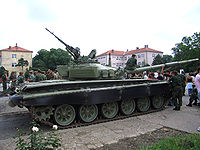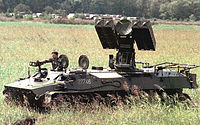- Military of Serbia and Montenegro
-
Military of Serbia and Montenegro 
Seal of the Military of Serbia and MontenegroFounded May 20, 1992 Disbanded June 5, 2006 Headquarters Belgrade Leadership Commander-in-Chief President Dobrica Ćosić (1992-1993)
President Zoran Lilić (1993-1997)
President Slobodan Milošević (1997-2000)
President Vojislav Koštunica (2000-2003)Commanders of General Staff HQ Colonel General Života Panić (1992-1993)
Colonel General Momčilo Perišić (1993-1998)
General of the Army Dragoljub Ojdanić (1998-2000)
Colonel General Nebojša Pavković (2000-2002)
Colonel General Branko Krga (last Chief of the General Staff)Manpower Military age 19 years Related articles History Bosnian War, Kosovo War, Preševo Valley conflictRanks Ranks and insignia of the Military of Serbia and Montenegro The Military of Serbia and Montenegro (1992-2006) (Serbian: Vojska Srbije i Crna Gore, VSCG; Војска Србије и Црне Горе, ВСЦГ) were the armed forces of the Serbia and Montenegro. The military included ground forces with internal and border troops, naval forces, air and air defense forces, and civil defense.
Preceding the VSCG was the Military of Yugoslavia (Serbian: Vojska Jugoslavije, VJ; Војска Југославије, ВЈ) from the remnants of the Yugoslav People's Army (JNA), the military of SFR Yugoslavia. The state, then named "Federal Republic of Yugoslavia", participated in the Yugoslav Wars, but with limited direct intervention of its own armed forces. Following the end of the Wars and the constitutional reforms of 2003 by which the state was renamed "Serbia and Montenegro", the military accordingly changed its name to "Military of Serbia and Montenegro". The military was heavily involved in combating the separatist Kosovo Liberation Army and Liberation Army of Preševo, Medveđa and Bujanovac during the Kosovo War and Preševo Valley conflict, and also engaged NATO airplanes during the 1999 NATO bombing of the Federal Republic of Yugoslavia.
Upon the dissolution of Serbia and Montenegro with the Montenegrin independence referendum of 2006, a fraction of the joint military was given to Montenegro, with the bulk of the force remaining in Serbia.
Contents
Ground Forces
 Official seal of the Military of Yugoslavia, prior to its renaming
Official seal of the Military of Yugoslavia, prior to its renaming
Armoured vehicles
Artillery
Air Defence
- Bofors 40 mm gun L/70
- M53/59 Praga - 100-200
- SA-7
- SA-14
- SA-18
- SA-9
- SA-13
- SA-3
- SA-6
Infantry Weapons
- CZ-99 Pistol 9 mm
- M70A/M70B1 Assault Rifles 7.62 mm
- M93 Black Arrow Long Range Rifle
- BGA
- M76 7.9 mm Sniper rifle
- M72 7.62 mm Machine gun
- M84 7.62 mm Machine gun
- M87 12.7 mm Heavy Machine gun [2]
- AT-3 Sagger
- AT-4 Spigot
- M79 "Osa" 90 mm
- M80 "Zolja" 64 mm rocket grenade launcher
Air Force
Main article: Air Force of Serbia and MontenegroAircraft Origin Type Versions In service 1998 In service 2003 Notes Mikoyan-Gurevich MiG-21 Fishbed  Soviet Union
Soviet UnionFighter
Trainer
ReconMiG-21 Bis
MiG-21 UM
MiG-21 MF/R54
8
2/426
6
1Mikoyan-Gurevich MiG-29 Fulcrum  Soviet Union
Soviet UnionFighter
TrainerMiG-29A
MiG-29UB14
24
1SOKO J-22 Orao  SFR Yugoslavia
SFR YugoslaviaGround Attack
Trainer
Rece
Rece-TrainerJ-22
NJ-22
IJ-22
INJ-2235
10
~10
216
7
8
2SOKO G-2 Galeb  SFR Yugoslavia
SFR YugoslaviaFighter Bomber & Trainer G-2š <20 1 SOKO G-4 Super Galeb  SFR Yugoslavia
SFR YugoslaviaFighter Bomber & Trainer
Unarmed Trainer
Target puller
PrototypG-4
G-4š
G-4t
G-4M48
8
4
123
8
2
1Antonov An-2 Colt  Poland
PolandCargo Aircraft An-2TD 4 1 Antonov An-26 Curl  Soviet Union
Soviet UnionCargo Aircraft An-26B 12 2(6) Yakovlev Yak-40 Codling  Soviet Union
Soviet UnionVIP Aircraft Yak-40 4 1-2 Mil Mi-8 Hip  Soviet Union
Soviet UnionTransport Helicopter
Multirole HelicopterMi-8T 44 29 Mil Mi-14 Haze  Soviet Union
Soviet UnionAnti-Submarine Helicopter Mi-14PL 3 0 All destroyed during the war in Kosovo Kamov Ka-25 Hormone  Soviet Union
Soviet UnionAnti-Submarine Helicopter Ka-25PL 4 0 3 destroyed during the war. Last one withdrawn, now in Belgrade Aviation Museum Kamov Ka-28 Helix  Soviet Union
Soviet UnionAnti-Submarine Helicopter Ka-28PL 2 0 Withdrawn, now in Belgrade Aviation Museum Aérospatiale SA-341/-342 Gazelle  France/
France/
 SFR Yugoslavia
SFR YugoslaviaUtility
Recon
Attack Helicopter
Attack helicopterHO-42/45
HI-42 Hera
HN-42M Gama
HN-45M Gama 230
3
27
1529
3
19
11The Federal Yugoslav Navy was based in the Kotor and was largely made of vessels inherited from the SFR Yugoslav Navy. During NATO's Operation Allied Force in 1999, the Navy took control over civilian shipping around Kotor, despite NATO's blockade[3] and in several actions the warships fire at NATO aircraft on their way to strike Serbian targets.[4] The Navy claimed to have shot down three UAVs over Boka Kotorska.[5] The images of the remains of one of them were displayed online.[6]
- Koni class frigate (2)
- Kotor class frigate (2)
- Heroj class submarine (3)
- Sava class submarine (4)
- Una class submarine (5)
- Končar class guided missile gunboat (6)
- Osa class missile boat (10)
- Jadran sailboat
- Neštin class minesweeper (7)
- Kozara river ship
Operational experience
-
- War with Albanian guerrilla groups (1998-1999)
- Attack on Prekaz
- Battle of Košare
- War with NATO (1999)
- Presevo Valley Conflict (2001)
- War with Albanian guerrilla groups (1998-1999)
Statistics prior to split
 The M-84 Main Battle Tank
The M-84 Main Battle Tank
Civilians fit for military service were estimated at about 4,888,595 (2001 est.). The 2002 estimate for military expenditures as percent of GDP was 4.6%. Significant reforms were undertaken in the military of Serbia and Montenegro. In 2002 the Serbo-Montenegrin Military force numbered around 100,000 soldiers, supported by some 450,000 reserves. The 100,000 strong Army had 1,500 main battle tanks and 687 armed infantry vehicles. The Navy had 3,500 personnel, of whom 900 were marines. The entire Navy was composed totally out of 6 submarines, 3 frigates, 41 patrol & coastal ships and 14 "other" vessels. The Air force 14,000 personnel had 192 combat aircraft and 72 armed helicopters.
Military branches
- Army (Kopnena vojska - KoV VSCG)
- Air Force and Air Defense (Ratno Vazduhoplovstvo i Protivvazdušna odbrana - RV i PVO VSCG)
- Navy (Ratna Mornarica - RM VSCG)
Military manpower - military age: 19 years of age (2003 est.)
Military manpower - availability:
males age 15-49: 3,579,620 (2003 est.)Military manpower - fit for military service:
males age 15-49: 3,077,660 (2003 est.)Military manpower - reaching military age annually:
males: 101,547 (2003 est.)Military expenditures - dollar figure: $954 million (2002)
Military expenditures - percent of GDP: 4.6% (2002. est.)
International Deployment
The VSCG was part of MONUC, the UN mission in the Congo. The VSCG was also part of UNAMSIL, the UN mission into Sierra Leone.
Last chief of staff of the Military of Serbia and Montenegro was general Ljubiša Jokić.
Gallery
-
Yugoslav Army T-55A and US Army M1 Abrams MBT during YA withdrawal.
See also
- Yugoslav Peoples Army
References
- ^ Yugoslavia Ground Forces
- ^ "Arsenal" magazine, 15 October 2007 (Serbian)
- ^ Crisis in the Balkans: The Blockade, by Steven Lee Mayers, The New York Times, May 5 1999
- ^ Between Milosevic and the West, montenegro's balance of fear, by Anna Husarska The New York Times, April 17 1999
- ^ Where is the air survaillance and attack capability over today's non-linear battlefields?
- ^ UAV Remains in Yugoslavia
External links
- Serbian and Montenegrin Armed Forces / Vojska Srbije i Crne Gore - VSCG
- Army of Yugoslavia / Vojska Jugoslavije
- The Great Secret of Serbian Military Affair, which covers the time when Serbia and Montenegro was in the state union
- Encyclopedia of the Nations
Categories:- Military of Serbia and Montenegro
- Military units and formations established in 1992
- Disbanded armies
Wikimedia Foundation. 2010.




